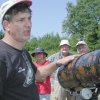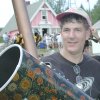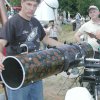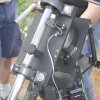

Article by Bruce Berger




- Name: Bruce Berger from Chelmsford, MA
- Instrument: 8" f/5 Newt-GEM
- Entry: [07]
- Movie of this Scope, WMV format, 7.2 Mb
- Innovative Component Award: Fabric Tube Cover and Folding Equatorial Head.
- 3rd Place Optical - under 12½"
My Telescope
In January 1999, I started an 8” f/5.3 mirror with the intent of finishing up by Stellafane that year. Little did I know that I was starting a 3-1/2 year adventure.
Things went well in the beginning. After my induction into the Amateur Telescope Makers of Boston, and purchasing the mirror kit, StarBob Collara had me polish the back flat - a task I thought was a waste at that time, but which later proved itself. Bob Cohen had made an aluminum tool with a cutting face made up of stainless steel washers embedded in epoxy, and I was eager to try it because it was said to make the rough grind go faster. And faster it was, as I graduated to the polishing room after just 12 hours.
I never did get the strokes right in the beginning. I was too fast. Fast because I wanted to finish, but the tortoise was right, not the hare. Slow and steady, 1/3 stroke, completely random. I went through all of the usual beginner’s problems-hole in the middle, turned down edge, turned up edge, hole in the middle, hole in the middle, hole in the #$%^ middle! I went back to a sphere so many times during the process that I lost count.
I thought that if the pros can do it with machinery than so can I. A couple of Sundays at Dave Shue’s polishing machine, then several sessions on the club’s polisher got me mostly spherical, but always with some type of zoning. Again I proved the tortoise right. Slow and steady, 1/3 strokes, completely random.
During the Thursday mirror session I had many advisors. Mike Mattei, StarBob, Ed Los, Phil Rounseville. In the end I found out that they were all right, and I applaud their efforts to get me over the various hurdles I encountered. But what I learned is that every one of them has their own technique, and they all probably work, but they don’t all work at the same time. To solve a particular problem, Advisor #1 would tell me mirror on top, tangential strokes, lean on the edge. After a while of this and a trip to the Foucault tester, Advisor #2 would tell me tool on top, center over center, long strokes. While I was doing this, Advisor #3 might happen by with a different method. So I wound up combining methods - maybe not consciously, but in a way that would appease my quest to get it done and make my advisors happy.
This was wrong, way wrong! Pick a method, pick an advisor, whether it be in print or person, and stick with it. There is no fast way. Slow and steady, 1/3 stroke, completely random.
Several times I had a 1/4 wave, or even a 1/7 wave mirror. StarBob even announced that my mirror was ‘finished’ in the President’s Message of one of our newsletters. But I was determined to make it better than average, especially after 3 years of working this same piece of glass. I wanted something to last a lifetime, not something I’d want to replace as soon as it was finished. So I kept going, and going, and going. Back to a sphere, slow and steady, 1/3 stroke, completely random.
I was getting the hang of it; I was starting to understand how the glass would react to my massaging strokes, but I was still facing hurdles.
It was Mike Hill that “showed me the way” in the end. Mike’s technique was to heat the lap and mirror in a bucket of water, then press for 20-30 minutes before polishing. Now this was contrary to what at least one of my ‘advisors’ had said, but there was Mike, working his 10” side by side with me every week, and he was making progress without many of the misshapen figures that I was creating.
It was this technique that brought me to the finish line. A beautiful mirror, almost 1/18 wave on the Foucault. A nearly flat line on the wave front error graph, and something I could be proud of for the rest of my life. I called it finished.
Thank you ATMoB, for being there when I needed you. Thanks for all of the Thursday nights of camaraderie, frustration and education. Thanks for the stressless evenings when family and job pressures were left at the clubhouse door. Thanks to the many advisors, whose methods work; they just don’t work when you mix them together. Thanks for teaching me about physics, about the stars, about patience and perseverance.
And thanks Stellafane and the Springfield Telescope Makers, for giving me an additional, tangible target, and for recognizing the hard work and the learning that went into my telescope. I may not have finished in time for the ’99, ‘00 or even the ’01 competition, but I’ll remember the ’02 convention every time I gaze at my scope, and every time I use those Nagler eyepieces!
My telescope-doesn’t it sound special? My Telescope! I didn’t just go to the store and buy it. I made it, with my own hands, slow and steady, 1/3 stroke, completely random.
Bruce Berger, August 19, 2002
Back to the 2002 Convention Main Page